|
By: Rocco Casullo – St. Thomas Aquinas HS (FL) Originally Published in: Nike 2013 Coach of the Year Clinics Clinic Notes - by Earl Browning Thank you very much. My topic today is defensive football. We feel that is the way to win football games. We have a number of goals for our defensive team. We want to win the game. Our goal is to force field goals and prevents touchdowns. It is our job to take the ball away from the opponent's offense. We want to set up good field position for our offense. We must control the momentum of the game and win our first series of the game. That is extremely important to our defense. Our number one objective for the defense is not allowing big plays. On first and second down we want to stop the run. We must defend the middle of the field first. We defend the field from the inside/out. On third down, we mix in some zone blitzes against the passing game. We want the ball thrown short and outside in that situation. We let the speed take over and let the safeties get to the corners. We want to play gap sound on every situation that presents itself. We want to execute the defense successfully. To do that you must have good communication and teamwork. The defense must be mentally tough to deal with "sudden change" in the game. Those situations happen very quickly. Our motto on defense is, if you think you stink." We want them to shut their mouths and hit people. We want to get players in position and get them going fast and forward. The first thing I want to talk about is what we refer to as a "max-set." That involves "one and no back" sets. We name the offensive formations by city names. We try to make it easy for our players to identify formations. The first set is a "Destin" set. That formation is a spread 2 X 2 formation with a tight in the set. We want two blitzes for each formation. It is like a vocabulary test. You try to memorize as much as you can. That keeps it simple. In this set, we have a "Destin X-call." (Diagram #1) We are a "3-4" defense. The inside linebackers are Mike and Will. The outside linebackers are Sam and Rush. The Sam linebacker is the strong side linebacker and the Rush is the open side linebacker. We play with Mike to the call side and Will to the away side. The X-call, involves the Mike, Will, and nose guard. The nose has a "NOB" technique. That means on the snap of the ball the nose is going outside into the B-gap. We identify the direction by the alignment of the one-back in the backfield.
Our Rush linebacker is our hybrid linebacker. He can come off the edge, play good run support, and match the number 2 receiver in the twin set. In this front, he has the number 2 receiver, He could have a "banjo" switch call with the corner to his side. We try to disguise everything in the secondary as a cover-2 shell. The corners are up and the safeties align at 10 yards. At the last second before the snap, we adjust to what we are going to run. On this play, the strong safety to the tight end side rolls down and becomes a box player. He is a robber player or a low-hole player. If the back releases he has him, or he can play the tight end. We have to play tough man coverage with the corners on the number I receivers to their side. The up-front rushers must get to the quarterback. This is a gamble for the defense. This is a five-man pressure scheme. The Sam linebacker is a lock down defender on the tight end. He has to get his hands on him and control him. He has to limit the tight end from doing anything to beat us. This is the first blitz we use in the Destin formation. You can use these blitzes against any formation. In the front, the open side end aligns in a 6-technique and has contain responsibility on the pass. The nose guard aligns in a 0-technique head up the center. To play this defense, the nose has to command a double team or at least hold his ground. The tackle plays a 5-technique on the outside shoulder of the offensive tackle; however, he is a B-gap defender on this stunt. The Sam linebacker aligns in a 9-technique. The Sam linebacker gets his hands on the tight end and plays the running back if he releases to the flat. The base defense is an "Okie" front. We are a one-gap defense. We want to keep all blockers off the linebackers. We call the 2 X 2 spread-formation with no tight end "Detroit." From this set, we run "Smoke" and "War." (Diagram #2) We like to run this stunt to defeat the option play. If we run "Smoke", that is the Sam and Mike linebacker blitzing off the edge. We base the stunt off where the running back sets in the backfield. The tackle aligns in a 5-technique and long sticks all the way over into the A-gap to the side of the stunt. The nose guard is in a 0-technique and slants into the weakside A-gap. The defensive end aligns in a 6-technique and he is the contain players to the backside.
The Rush linebacker is the seam player. The corners play cover-3. The free safety is the middle of the field player. The strong safety is the seam player to the stunt side of the formation. The Mike and Will linebackers, must key the back. If a back flares, they must take him. This is a great call against the zone read play. The only way to defend the option is to attack it. You cannot sit back and play the option. Teams will find out what we are doing and move their set back at the last minute. When they do that, we check from the "smoke" call and run the "war" blitz, which is the same blitz to the other side. (Diagram #3)
The end runs the long stick into the A-gap and plays the dive. The nose goes into the strong A-gap. The Rush comes off the edge as the low blitz and the Will linebacker comes off the edge as the high blitz. The strong safety comes to the middle and the free safety rolls down into the weak flat. If we have a balanced set, we run the blitz to the field side. We did not see any pistol sets this year, but if we do, we run the blitz to the field. We play teams that run the 3 X 1 bunch-set. Against this set, we make a "Sugar" call. (Diagram #4) The 5-technique defensive end slants into the B-gap. The nose is a 0-technique defender and plays the A-gap. We want him to maul the center. The tackle is a 5-technique defender. We want the tackle to bull rush the offensive tackle but we want him to work to the inside. That is an important point. The Sam aligns on the point receiver in the bunch set and jams him. He is coming on a contain blitz.
On a pass, he wants to get under a slant pattern by the number I receiver. If there is no slant, he plays the curl/flat area. The strong safety rolls down and plays the flat area to the bunch side. The corners play cover-3 and the free safety rolls into the middle third. When a team aligns in the bunch set, they try to create problems by crossing and rubbing defenders. The Mike linebacker has to be the wall player on the number 3 receiver in the bunch. The Sam linebacker aligns on the point receiver and beats him up. The patterns in the bunch depend on the point receiver releasing off the line. Any inside routes coming from the number 3 receiver, the Mike linebacker has to get his hands on him. The strong safety stems down and replaces the Sam linebacker. The Sam linebacker blitzes off the edge and the strong safety works to the flat zone. The bunch package like to send the number 3 receiver up the seam deep. That is why it is important for the Mike linebacker to get his hands on him to slow him down. The free safety rotates back through the middle and picks up that pattern. The corners play cover-3. The Will linebacker gets under the number 1 receiver. However, he has to see the back in the backfield. If he releases, the Rush linebacker should be home free on the quarterback. If something happens, the Will linebacker has to play the wheel or seam from the back in the backfield. Toronto is a three-wide receiver set. The blitz is "Swim" (Diagram #5) The Sam and Will linebackers run the blitz. The defensive end slants into the B-gap. The nose slants into the weakside A-gap. The tackle slants into the weakside B-gap. The Rush linebacker takes away the slant by the number 1 receiver to his side and plays the running back to his side. The Mike linebacker plugs his gap on the run and plays the hook/curl to the strong side. If the number 3 receiver comes out of the backfield, he has to wall him to the outside. Our free and strong safeties are almost like linebackers. They are strong run supporter and must read the runs. If we get a run to the weakside, the Rush linebacker has to take on pulling guards and fullback. The free safety has to read those schemes and react up in support. The Rush linebacker does not come late. He reads the play, get to his area and sits down. He is responsible for any screen that way. This defense puts a lot of pressure on the Rush linebacker. When we align the linebacker on air, we put them in a quarter-turn to the inside. That points them at their keys and allows them to react quicker to where they need to go. Any formation we see we play the run read first. The Rush end reads the offensive tackle for his key. If he gets the high hat or pass set, he play pass. When we blitz, we apply the motto. "If you think, you stink." If they are going to think, they must do it while they are rushing the quarterback. When we blitz, we must get home. You must react and go get the quarterback. We call the empty sets, "Eagle." The call we like against the empty is "Ram". (Diagram #6)
The Mike and Rush linebackers are coming off the edge in this blitz. The Will linebacker aligns in a 0-stack behind the nose guard. He drops to the box and takes the number 3 receiver if he comes inside. The free safety drops down to the two-receiver side and plays man-to-man coverage on the number 2 receiver. The corner plays the number 'I receiver in man coverage. The free safety and corner play "banjo" coverage on the two receivers. That means they zone off and play man on the receiver that come toward them. On the three-receiver side, we play box coverage. The Sam linebacker aligns on the number 3 receiver and plays the flat. The corner comes off and plays the deep third. The strong safety rolls down on the number 2 receiver and plays the hook/curl zone. Any time a team goes to an empty set we expect to get a sack. The Rush linebacker comes off the edge and the defensive end slants inside. One of those players usually makes the sack. It put a tremendous amount of pressure on the offensive tackle and there is no back in the backfield. We do many run blitzes. Against a two-back set, the main thing is to have all gaps covered. In this blitz we go to the "under" front. We call this blitz, "Under Wolf' cover-1. The Wolf call is the Will linebacker. (Diagram #7)
The nose aligns in the strong A-gap and cross the centers face into the weakside A-gap. The Will linebacker blitzes through the strong side A-gap. The 5-technique defender is the B-gap defender. The strong safety rolls down and plays head up the tight end at linebacker depth. He is a C-gap defender from this position. We play cover-1 in the secondary. The corner locks up with the number 1 receivers and the free safety is the middle of the field safety. We lock the strong safety on the tight end. If the end blocks, the strong safety becomes an additional box player. The coaching points go to the Sam and Rush linebacker. If any back comes out of the backfield into the flat zone, Sam and Rush must take them. It is hard for the Sam linebacker because he has to play his technique on the tight end. However, if the back releases, he has to go right now. The same thing is true with the Rush linebacker. His alignment allows him to have better vision on the back in the backfield. He can see the offensive tackle and the back. We are in man-coverage on the corners. If the back comes out and the outside linebackers miss him, the back can run forever. If the inside linebackers are not good at reading their triangle reads, get them playing forward. Do not let them sit and catch blocks. The weakest link in this front is the defensive 5-technique tackle. If you do not have a tackle that can stay in his gap it makes it hard on the Mike linebacker and safety. If the blockers turn the tackle, and the tight end gets off on the Mike linebacker, it puts a lot of pressure on the safety to make the play in the C-gap.
If we run the Snake Blitz, the Mike linebacker does not blitz. In a pro-twins set, we can run "under/Mink." The front is an under front and the Mike linebacker blitzes the weak side A-gap. (Diagram #9) This is a simple blitz. The nose comes off his shade on the center and slants hard into the strong A-gap. The Mike linebacker cross the center and blitzes the weakside A-gap. If we play cover-1 as the coverage, we bring both corners to the same side and cover, the twins set.
When we game plan each week, we have two blitzes for every formation. If they are one-back, two-backs, or no-backs, we have two blitzes for each formation. If the offense adjusts to the first set of blitzes, we make adjustments and go to plan B. If you play teams that will let you bring the strong safety into the box, put him in there. That is the key to the blitzes. He can make 12-14 tackles a game from that position. If teams are in 21 and 22 personnel groupings, the strong safety should be down in the box. The Sam linebacker is a C-gap defender. If the tight end blocks down, he gets his hands on him, and stays in the C-gap. If anything runs outside of him, the strong safety is the force player and he pursue from the inside/out. We put the Rush linebackers in a quarter tilt so they can see the tackle, pulling guard, and the back. They must use their peripheral vision to see all they need to see. They have to learn how to play in space. We call the twins-open a "bomber set." (Diagram #10) We run a "Rinse" blitz. This blitz is the Rush and Sam linebackers on an inside blitz. This is good against a two-back zone read team. This confuses the blocking scheme for the guards. The defensive end and tackle align in a 4i-technique and long scoop to the outside. The nose plays down the head of the center. The Sam and Rush linebackers blitz the B-gaps through the offensive guards.
Alabama runs this blitz many- times. This is a good blitz to disrupt a zone read by the quarterback. The Sam and Rush linebackers on this stunt must go. There can be no hesitation. When the down defender long scoops outside, they must be right off their butts and attacking the guard. It is a great blitz against the run and the pass. The technique of the nose playing in a 0-technique can be a two-gap technique. We tell him to maul the center and play football. He cannot let the center turn him. If the guard blocks down on him, he must hold his own. They cannot take him off the ball or turn him so they can slip to the backside linebacker. When the Rush and Sam linebacker come from the outside, they key the guards. If the guard turns out on them, they know they must close into the A-gap. They must play through the guards. If the guard turns inside to double the nose, the linebacker plays his hip. He comes tight off the hip of the guard and plays football. If they attempt to scoop on the nose, the linebacker blitzing through that gap will make the play. He will run it down before it can get to the other side. He has to be aware of the offensive lineman that will try to block him. The backside offensive tackle on plays away from him has to secure the B-gap. The blitzing linebacker has to know that block is coming and play through it.
The Will linebacker is outside the Sam linebacker to the boundary. The strong safety is in the same position to the strong side of the field. We are in cover-1 in the secondary. The free safety is in the middle of the field and plays deep as the deepest. If anyone comes out of the backfield in motion, we must man-up with him. If the running back becomes the number 2 receiver to the boundary, the Will linebacker takes him. The strong safety rolls down into the box. If there is motion to his side, he covers it. The Mike and Will linebackers are over the guards 90 percent of the time. With the Mike linebacker in the middle, he has a triangle read. The strong safety and Will linebacker are outside and read the guards. The hardest thing to teach the safety is how to read in the box. If you play the Okie front, you must have good coaches to put it together. The odd front puts pressure on the end, tackle, and nose. They need coaches that can help them play the variations of the techniques. The only time we had any trouble with preparation was against Byrnes High School out of South Carolina. They were a good veteran team with a smart quarterback. We lined up to run the first blitz and the quarterback stepped back and called an audible. We checked the defense, to the second call. The quarterback called another audible. We did not have another blitz. We are all right most of the time unless you go deep into your playbook. In the spring we install all the verbiage and calls. We can run any of the blitzes I just showed you with any formation. I appreciate your time and attention. I will be around if you have questions. Thank you very much. |
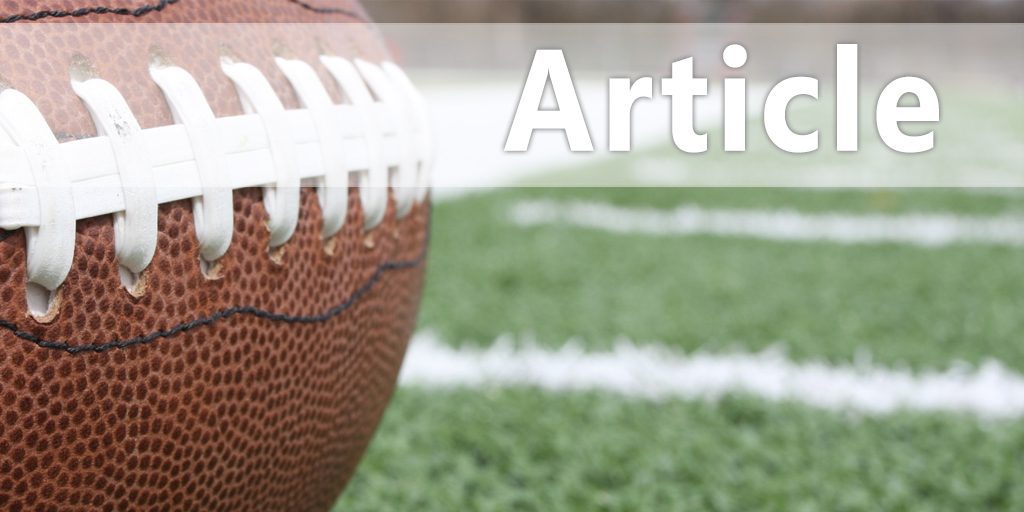


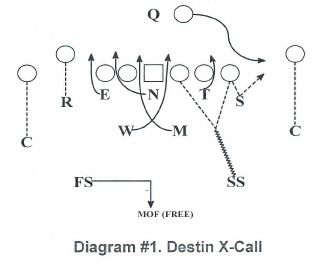 The Mike linebacker aligns on the two- receiver side and blitzes the A-gap to the tight end side. It is an X-stunt in the middle, and the Mike linebacker is the first blitzer. The nose guard plays across the guard's face and gets into the B-gap to the two-receiver side. The Will linebacker is the second blitzer. He crosses behind the Mike linebacker into the A-gap to the two-receiver side.
The Mike linebacker aligns on the two- receiver side and blitzes the A-gap to the tight end side. It is an X-stunt in the middle, and the Mike linebacker is the first blitzer. The nose guard plays across the guard's face and gets into the B-gap to the two-receiver side. The Will linebacker is the second blitzer. He crosses behind the Mike linebacker into the A-gap to the two-receiver side.
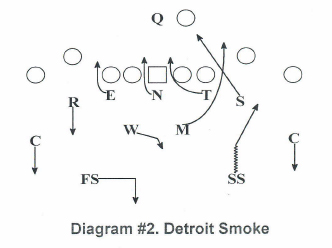 The Sam linebacker aligns two yards outside the offensive tackle and two yards off the line of scrimmage. He comes off the edge in a tight path to the running back in the set. The Mike linebacker aligns in a 20-technique on the guard and high blitzes off the edge outside the Sam linebacker. If it is a zone play, the Sam linebacker has the dive. The Mike linebacker comes off the edge and plays through the quarterback to the pitch if they run the inside zone read or option. The Will linebacker is the backside player.
The Sam linebacker aligns two yards outside the offensive tackle and two yards off the line of scrimmage. He comes off the edge in a tight path to the running back in the set. The Mike linebacker aligns in a 20-technique on the guard and high blitzes off the edge outside the Sam linebacker. If it is a zone play, the Sam linebacker has the dive. The Mike linebacker comes off the edge and plays through the quarterback to the pitch if they run the inside zone read or option. The Will linebacker is the backside player.
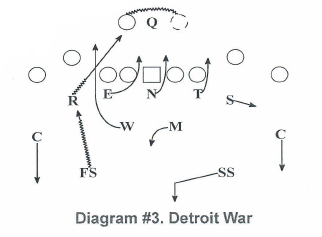 We call the blitzes by the letters of the players. smoke is Sam and Mike running the blitz. The war is the Will and Rush
We call the blitzes by the letters of the players. smoke is Sam and Mike running the blitz. The war is the Will and Rush
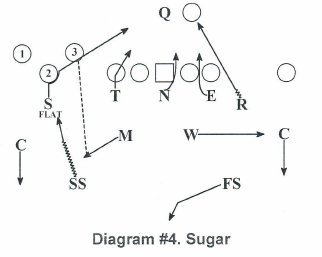 The Mike linebacker plugs the B-gap on runs and plays the hook/curl zone on a pass. The Rush linebacker aligns 3 yards outside and 2 yards back off the offensive tackle and blitzes off the edge. The Will linebacker plugs the A-gap on run.
The Mike linebacker plugs the B-gap on runs and plays the hook/curl zone on a pass. The Rush linebacker aligns 3 yards outside and 2 yards back off the offensive tackle and blitzes off the edge. The Will linebacker plugs the A-gap on run.
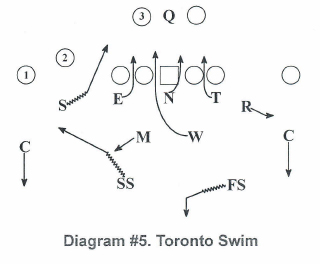
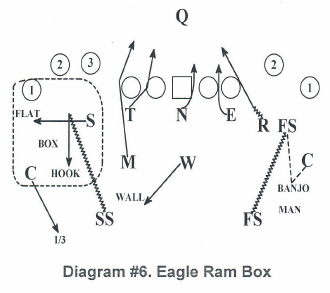 The "ram" is the Rush and Mike linebacker. In this set, the Mike linebacker stacks behind the 5-technique tackle to the three-receiver side. The tackle slants inside to the B-gap. The nose is in the 0-technique on the center. The end aligns in a 5-technique and slants into the B-gap. The Rush linebacker is outside to the weakside.
The "ram" is the Rush and Mike linebacker. In this set, the Mike linebacker stacks behind the 5-technique tackle to the three-receiver side. The tackle slants inside to the B-gap. The nose is in the 0-technique on the center. The end aligns in a 5-technique and slants into the B-gap. The Rush linebacker is outside to the weakside.
 The nose aligns to the field A-gap. The tackle is in a 5-technique and the Sam linebacker is in a 9-technique. To the weakside, the defensive end aligns in a 3-technique on the outside shoulder of the guard. The Rush linebacker is three yards outside and two yards deep from the offensive tackle. He is in a quarter tilt toward the tackle and reading the tackle to the back in the backfield.
The nose aligns to the field A-gap. The tackle is in a 5-technique and the Sam linebacker is in a 9-technique. To the weakside, the defensive end aligns in a 3-technique on the outside shoulder of the guard. The Rush linebacker is three yards outside and two yards deep from the offensive tackle. He is in a quarter tilt toward the tackle and reading the tackle to the back in the backfield.
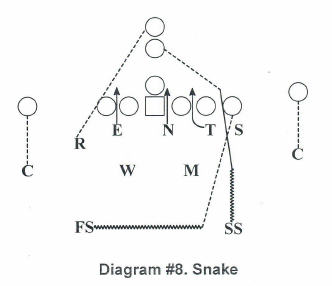 If we do not have a tackle that can fight off the slip block, we run a Snake call. (Diagram #8) On the snake call, the strong safety times his move and rolls down into the box and blitzes the C-gap. The tackle slants inside into the B-gap. That makes it easier on the Mike linebacker and the strong safety. To run this blitz, we change the coverage to cover-0 and we bring the free safety to that side to play the tight end in man-to-man coverage.
If we do not have a tackle that can fight off the slip block, we run a Snake call. (Diagram #8) On the snake call, the strong safety times his move and rolls down into the box and blitzes the C-gap. The tackle slants inside into the B-gap. That makes it easier on the Mike linebacker and the strong safety. To run this blitz, we change the coverage to cover-0 and we bring the free safety to that side to play the tight end in man-to-man coverage.
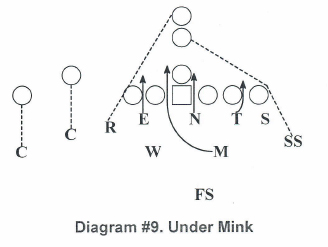 We bring the corners over when teams bring their two split receivers to the same side. The corners are more adapt at playing coverage in man coverage and pattern switching. They are used to playing the banjo call and do it better. Banjo is an important concept with teams that tries to rub off our defenders. The concept combines zone and man principles. It allows your corner to switch receivers when they cross. The inside corner plays the inside breaking patterns and the outside corner plays the outside breaking patterns.
We bring the corners over when teams bring their two split receivers to the same side. The corners are more adapt at playing coverage in man coverage and pattern switching. They are used to playing the banjo call and do it better. Banjo is an important concept with teams that tries to rub off our defenders. The concept combines zone and man principles. It allows your corner to switch receivers when they cross. The inside corner plays the inside breaking patterns and the outside corner plays the outside breaking patterns.
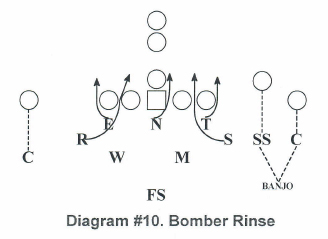 We can play cover-1 behind this blitz. The Mike and Will linebacker must take the backs coming out of the backfield. The strong safety and corner to the two-receiver side play a banjo technique with the twin receivers. The free safety is in the middle of the field playing as deep as the deepest receiver goes in the pattern. The corner to the single receiver side has him man-to-man.
We can play cover-1 behind this blitz. The Mike and Will linebacker must take the backs coming out of the backfield. The strong safety and corner to the two-receiver side play a banjo technique with the twin receivers. The free safety is in the middle of the field playing as deep as the deepest receiver goes in the pattern. The corner to the single receiver side has him man-to-man.
 If the offense has three-backs in the backfield, we call that a 'Bone." (Diagram #11)
If the offense has three-backs in the backfield, we call that a 'Bone." (Diagram #11)


